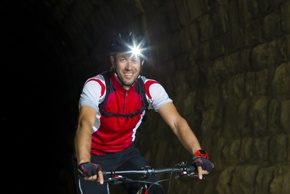Making Yourself and Your Bike Visible to Prevent Nighttime Ride Injuries
 You may ride a bike for pleasure, exercise, or transportation. However, if you don’t take adequate safety precautions, your ride could end tragically. Unfortunately for bicyclists, drivers are often more focused on avoiding a collision with another car than worrying about the presence of a potential biker. Even though biking is becoming more and more popular, drivers still fail to expect a bike in their blind spots, in crosswalks, or zipping through an intersection.
You may ride a bike for pleasure, exercise, or transportation. However, if you don’t take adequate safety precautions, your ride could end tragically. Unfortunately for bicyclists, drivers are often more focused on avoiding a collision with another car than worrying about the presence of a potential biker. Even though biking is becoming more and more popular, drivers still fail to expect a bike in their blind spots, in crosswalks, or zipping through an intersection.
According to the Center for Disease Control and Prevention, approximately 900 bicyclists are killed and nearly 500,000 are injured annually as a result of traffic and pedestrian collisions. A common reason given by those who collide with bikers? “I didn’t see him.”
Night Rider—How to Make Yourself Seen
Biker “invisibility” is a common excuse used by liable parties to partially deflect blame onto the injured rider. Consequently, not being seen is the number one cause of riders suffering extreme injuries. These risks are intensified at night, as visibility decreases. However, with the right equipment and mindset, you can avoid being overlooked, which can drastically decrease your risk of a collision.
The next time you choose to ride your bike after the sun goes down, protect yourself by remembering the following safety tips.
- Wear reflective or light-colored clothing. Although fluorescent clothing can make you more visible to approaching cars during the day, light-colored clothing will reflect more light at night, making you easier to identify. You can also purchase apparel specially designed for riding or running at night.
- Illuminate yourself and equipment. Attach reflective tape around your pedals, seat, and bike frame, as well as your helmet. You should also secure reflectors on your bike’s spokes and affix a headlight and tail light (Tennessee law actually requires headlights and rear lights on all bikes that are used at night). Proper lighting should provide 360-degree visibility. Remember, the idea is to make yourself stand out as a person and differentiate yourself from a road sign or stationary object.
- Assume that you’ll see others before they see you. Although you may be able to see a car approaching from a mile off, the driver will probably not be able to see you. Always assume that an approaching driver cannot see you and stay clear of his path. This is no time to fight for your right to be there.
- Plan your route ahead of time. Before embarking on your journey, plan your route to incorporate well-lit areas with light traffic. Even with a headlight, you should avoid dark roads with no safe bike lane. Cars can come up out of nowhere and will not be expecting to see a bicyclist in an isolated area. Check for a guide to safe bike routes in your community.
- Ride cautiously. Biking in full sunlight can be hazardous, but the risks exponentially increase when visibility becomes compromised. Don’t add to your risk by riding aggressively. Instead, make sure you follow traffic signs, yield to approaching vehicles (even if you have the right of way), consciously avoid riding in blind spots, and trust your gut. If you feel uneasy riding in a dark place, walk your bike to the nearest well-lit road.
If this article has piqued your interest, or you feel someone you love could benefit from reading it, please share it on your social media page. For more information on bike accidents, rider liability, and injury compensation, download our complimentary report, which includes resources and guidance for pursuing your claim—Request your FREE copy today!
To speak with an experienced attorney about a recent bike accident, contact our office today to schedule your FREE case evaluation. A simple click is all it takes to secure the protection and guidance of a firm willing to fight for you. Ensure your post-injury future isn’t overlooked—Contact GriffithLaw today to see how we can help you get your future back on two wheels.
|
Related Links: |

